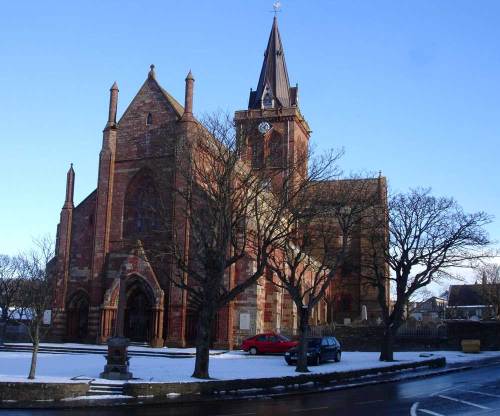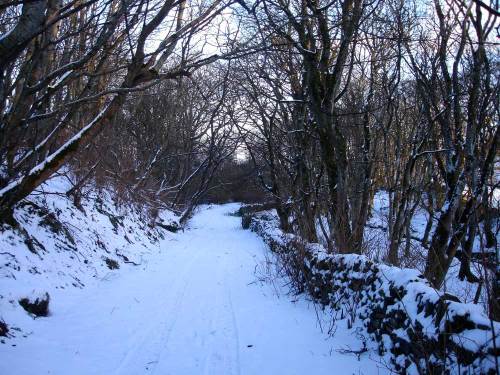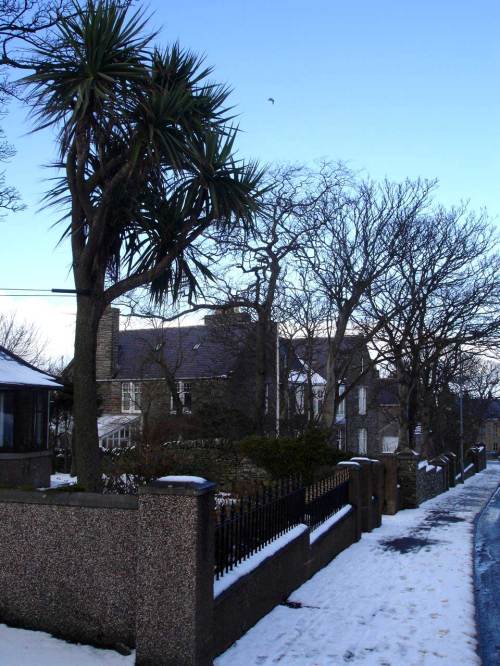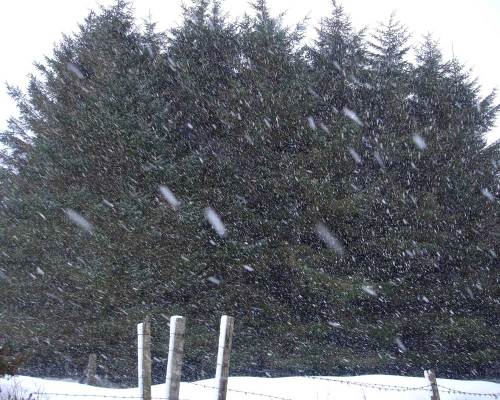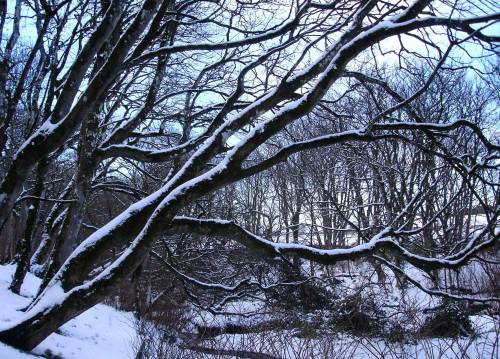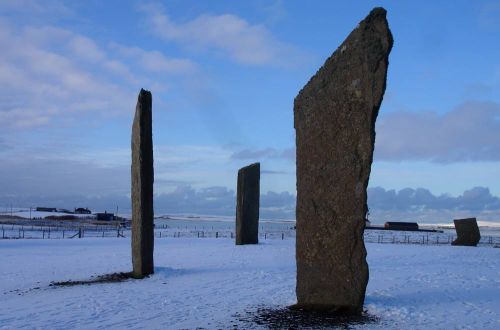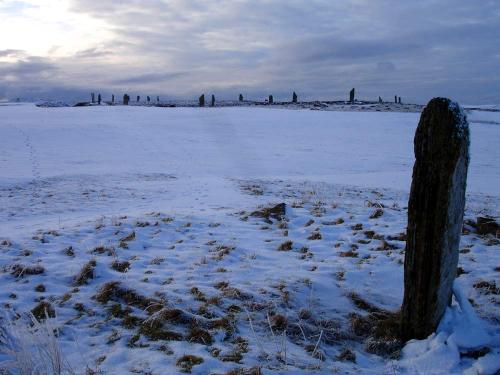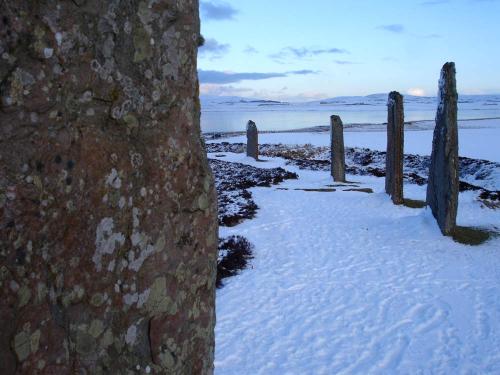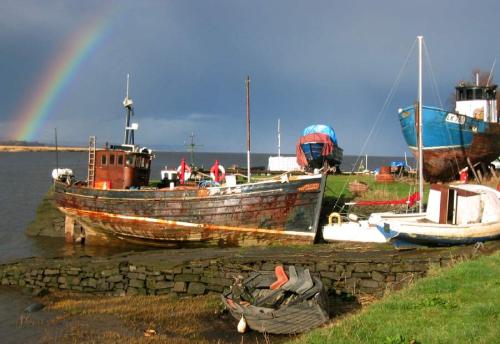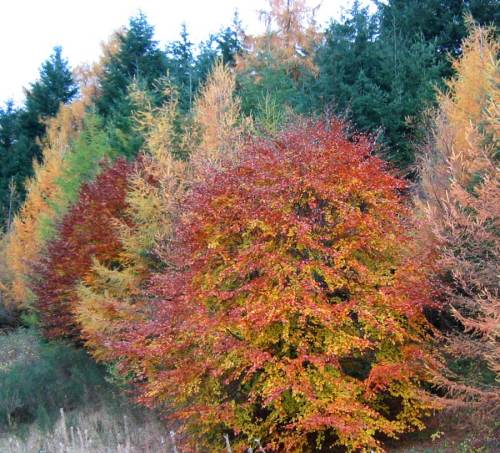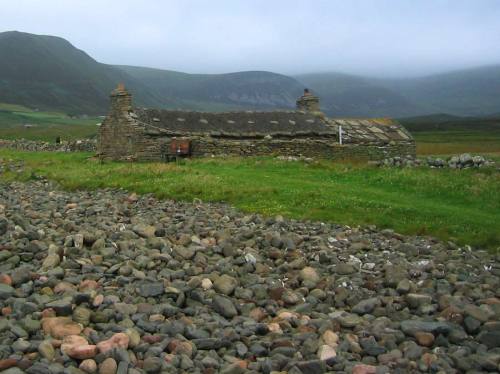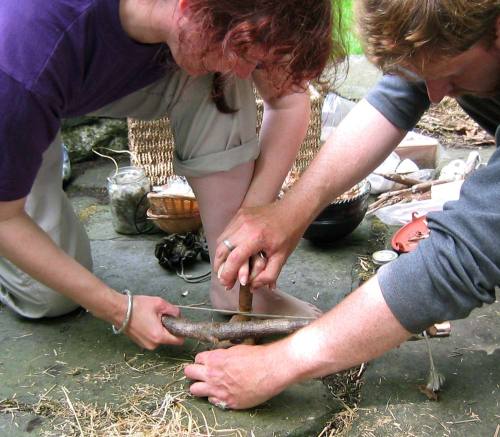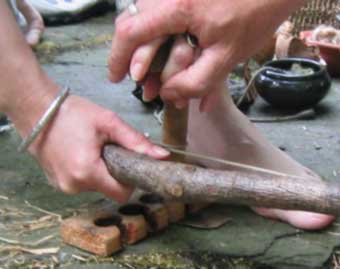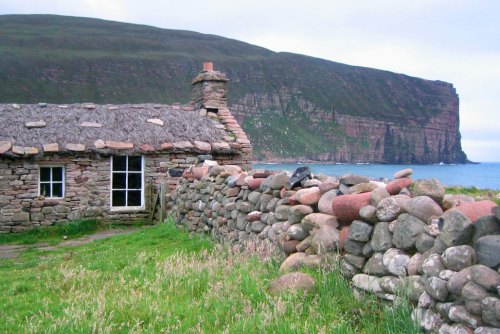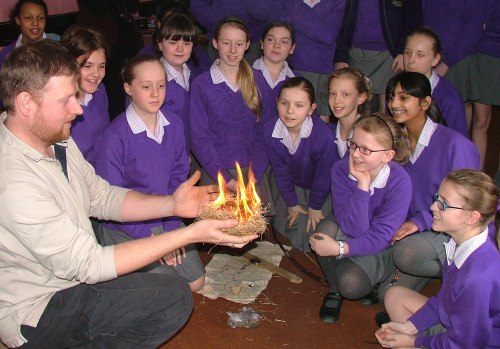One Man’s Journey along
the Skye to Crieff Cattle Drovers Route
By Malcolm Handoll, published 2003
The last time I did anything this stupid in public – I fell out of an aeroplane for charity.
It all started with a phone call to Trail Magazine looking for publicity for the Crieff Tryst. In some daft attempt to grab the journalists attention I ended up promising ever more – which left me needing high-quality photographs of myself and various idiots in costumes with live(ly) Highland Cows (with horns!) within three days. A sinch. Oh, and I’d also stated I was walking from Skye to Crieff along the old Drovers routes, averaging 22-25 miles per day (so what, they said?), bivvying out under the stars ‘like the old Drovers’ (well?) … and … and living on a Drover’s diet of porridge oats for a week (interest at last!!) … no chocolate (I had a story!!!)
So that was the plan – walk for a week along vague routes, sleeping out and eating rabbit food. After 6 months of not leaving my computer and a bum moulded to the shape of my swivel chair, and a distinct feeling of public pressure – a fixed arrival date that wouldn’t allow for delays of the ‘I had a blister/got lost/bored/broke my neck’ sort. Damn, I had to do this, without a stove, no money for ‘snacks’ en-route or the bus and no idea if my tendons would play ball.
Oh, and the photographs. Poo! Lots of cow poo, actually, as we stood in a field with Highland Cows looking cute (them) and nervous (them) and stupid (us) in our kilts, gortex, and costumes down the ages. No Wellington boots. Cows don’t like being told what to do by a photographer so we had to casually ‘walk’ into a herd of cows (with sharp horns) and stand as they inevitably bolted between us. Yeh, walking would be a sinch – and it WAS. It was fantastic -the best long distance walk I’d ever done as it turned out. This walk deserves to be a classic. Do it – but read on first.
Terry from Dun Caan Hostel (Kyleakin) dropped us off at the KyleRea Ferry and ‘G’ and I sailed the rapids that once drowned panicked coos, over the pinched gap that keeps Skye an isle, to Glenelg. Omens made me nervous, and ‘G’ felt it, felt the straps dig into soft shoulders. Conversation was sparse as we gauged steps, counting the metres and calculated the distance each day would necessitate. The mountains ahead showed no way through to ‘G’ – who’d joined this 1st leg with me, knowing nothing of Scottish mountains, Drovers or me!!! (We’d only once spoken on the phone – after she’d read the Trail Magazine article).
The Brochs in Glenelg took our minds off the mundane walking and navigation and from then on I was in a world of past lives. I was connected to the endless movement of humans and livestock across these mountains: seeping with memories, revealing hidden valleys and paths unlocking a natural route. My heart had reason to beat – it was magical! To follow such a natural route, leaving man-made paths in favour of the obvious gentle gradient, the lush pasture remnants, where cattle were grazed at night, fattened on their way to market by these skilled herders – the farmer’s ‘long-distance lorry drivers’ and security (they kept their guns) too. It all made such sense, and within the first hours of this walk, I am leaping around the tussocks of grass, a child transformed into a Drover, the journey inside my imagination.
From that first day on I was a drover and it felt great – to not just do a walk, but to understand why and to feel part of this history. Telford planned to use this route for the main road but I’m so glad he didn’t – it’s far too beautiful for that. Let the cars sweep down Glen —–, and leave this journey back in time, when the crags echoed the mooing of cows, the thwack of sticks and the bark of excited cow-dogs with occasional manly shouts. Now I had the rutting deer and felt satisfied.
Each day was marked by the passing of the ‘high-point’, the psychological barrier of that day, which once crossed left a sunset amble metaphorically downhill to some soft patch of grass. Of course G didn’t quite see it that way. I cajoled us on in an anxious bid for a raised knoll where a breeze would ensure midges stayed grounded. A week earlier it would have been very different and a tent would be wise – but Drovers didn’t worry. Mind you, they had whisky, and midges prefer cattle blood, so I’m told. I’m no ‘wuss’, but seven nights sleep deprivation worried me. So we slept on high ground and it was perfect.
Every place I wanted to rest, I found the grass richer and the water clean, sheltered but well drained, dry and midge free – I also found the remains of an old shieling or enclosure. Someone had been here before, many times – and I sincerely hope many stay there again. This walk is always following the natural route, the way you’d go before maps existed, just follow your nose, head in a general direction, think like a drover, and walk on.
‘G’ left after day two, reluctantly to return to civilisation’s commitments – it grabs you so quickly this walk, carries you into a land of dreams, feeds your imagination, and gives reason for each step, like no other – except maybe the pilgrims walks. And my body tuned in too. Eating complex carbohydrates proved a real success, and my pace adapted to the day’s rhythms, yet the slower energy release gave me such stamina, I continue to eat oats, out of choice.
A note on my diet; one of the rules – was no cheating – but hospitality would be welcomed in much the same way as Drovers would have stopped at farmsteads on route, maybe collecting cattle, or just saying ‘hello’.
Obviously, route choices were influenced by familiar stopping places, good pasture, avoiding worn or recently grazed routes and steering clear of trouble or less hospitable folk en-route – and this lends to the argument for a Drovers Route being flexible not a path. The cattle hated the sharp stones of hard core and I am in awe of those who wrestled the beasts to the ground to shoe them for road sections.
I ate raw porridge oats, and much as I love black pudding (the modern equivalent of the bloodletting Drovers supplemented their meagre diet with) I had no fuel to boil even water. I tried soaking the oats over night in cold water – and this was a real culinary masterpiece, different and bland as cold wall paper paste. I ate like a child, forced by hunger, not by pleasure – and for that experience I am forever grateful.
Wise to the nutritional demands of a weeks walking, and to replace the salt, protein and minerals otherwise hidden in cows blood, I enhanced my oats with the vegan equivalent of seeds, nuts and dried fruit (sugar-free muesli). This seemed sensible, true to my PR goal, and made munching on route palatable. Every stream crossed I drank from, so not to carry the weight of water, and I left my watch at the first one, day one!! I was putting it away in my rucksack for the week but its absolute loss made me even more in tune with the Drovers – time from then on followed the day’s weather and setting sun. (If anyone finds a charcoal grey Marmot fleece – it’s mine! Fell off whilst slipping through peat hags in the failing light and on wobbly, end-of-day legs).
Not knowing anyone on route, the hospitality option was severely limited. I therefore treated myself to one night under cover in a bothy (South Spean Bridge) – and a tiny fire, enough to heat hot water – real porridge, and some cheese, bread and tinned fish. It was also a day for cleaning seeping wounds, burst blisters (I never felt a thing) and realising the walk was quite a long way without any preparation. It began to look serious that day and I began to temper my enthusiasm, knowing the media awaited my return. How could I do that? What if my tendons swelled? – They did. By Loch Rannoch I couldn’t get my boot off it was so swollen, and trench foot has a peculiar smell, suitable only for solo walks and open air bivvying.
My concerns about conflicting access and landowners shooting deer didn’t materialise – in fact it prompted me to a route that is far more enjoyable and diverse than had I stuck to the ‘shortest line between two places’. Of course I contacted gamekeepers before setting off, and ensured they were happy with the plan (they were) and after Loch Ossian Hostel (tea stop) my route ‘detoured’ via Loch Rannoch – and I’m so glad I did! This kept the scenery changing constantly; never getting dull like a drudge up the West Highland Way.
This walk is characterised by its ever changing countryside – from Kintail and Knoydart’s wild beauty, to idyllic broadleaf woods beside still lochs, long tracks ideal for mountain-bikes, meandering streams, woods and rich farmland – and best of all, the whole way uses existing ‘natural routes’. That’s one of the joys – to walk in the footsteps of our ancestors – our inheritance. This walk is a journey, at the end of which you are in tune with nature, humanity and the seasons. Sleeping out allows the ultimate luxury of simply sleeping any where you like – beside the path, a kind bed of moss, a turfed lochside, a roofless hovel, they are yours for the night! literally! It is a route that is in essence many various routes, there is no right or wrong as such. My only sadness is that the many old buildings along the way are not restored to a basic bothy – that would be my long term dream – for they are in the best possible spots – chosen by our wise ancestors – the sheltered, watered land – complete with sunrise and stunning view! Had Telford’s road gone through these would be luxury holiday homes now. For a night at least, they were mine, complete with stars and air conditioning.
My only other suggestion to walkers of this route is not to have set days – but instead let the journey unfold, as if you are herding cattle and sheep, let the weather and the mood guide you, choose to explore and let your imagination run wild. I got ahead of myself, had to wait half a day for the media to arrive at our rendevouz, and like a true drover managed to wile away some hours in the coach house bar, with rowdy farmers and crazy musicians. It felt ‘as they would have done’.
I swear by the end of it I just wanted to keep on going – or turn round and go back. Whichever direction you choose, this walk is a classic.
The original text can be viewed at The Scottish Mountaineer
The Mountaineering Council of Scotland

Issue 20 October 2003
The Crieff Tryst takes place yearly in October. Go to the website for more information.
***

